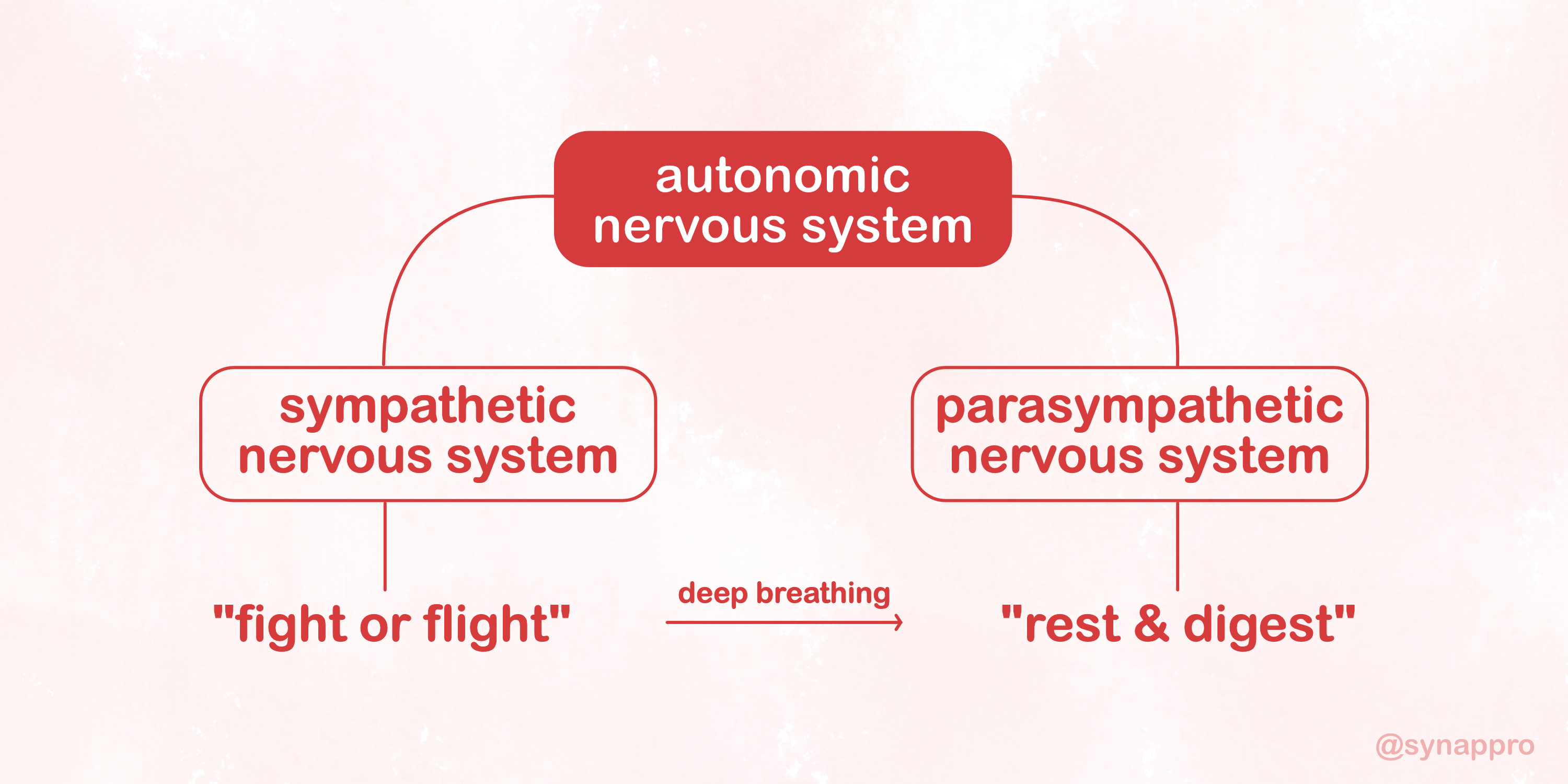
“Take a Deep Breath”: The Biology Behind a Powerful Habit
Published Thursday June 26th, 2025.
Written by Jenny Halseid and Dr. Ernest Wong.
At synappro, we believe meaningful change starts with the small things, like the way we breathe. A few mindful breaths can influence how we feel, think, and respond to the world around us.
Mindful breathing is one of the most well-established and accessible ways to support our mental and physical well-being. It’s simple, widely practised, and backed by a growing body of scientific evidence[1].
As we prepare to launch our guided breathing app, synappro breathe, we want to take a closer look at why this practice is so effective. While often associated with mindfulness and meditation, breathing also plays a direct role in regulating the nervous system, influencing how we respond to stress and maintain balance in our daily lives.
Why We Say “Take a Deep Breath”
We often hear the phrase “take a deep breath” in moments of stress. It comes up naturally before a presentation, during an argument, or after receiving bad news. What’s interesting is that this phrase isn’t just a figure of speech. It reflects an intuitive understanding that slowing the breath can help us feel more grounded.
What Happens in the Body During Stress
When we feel anxious, nervous, or overwhelmed, the body enters a state of high alert. Our breathing becomes faster and shallower, our heart rate starts to race and our muscles tense up. These changes are part of the body’s natural survival system. Thousands of years ago, they helped our ancestors run away from danger or respond quickly to threats.
Today, our challenges are different, but the body reacts in the same way. An overflowing inbox, a sudden deadline, or a difficult conversation can activate the same internal alarm. This can leave us feeling tense, restless, and emotionally drained, even if nothing dangerous is happening.
The problem isn’t the stress response itself. Rather, it’s the way modern life can keep this stress system switched on for long periods of time. Without clear signals that the threat has passed, the body struggles to return to a calm, balanced state[2].

How Mindful Breathing Interrupts the Stress Cycle
Mindful breathing provides the body with a clear signal that it no longer needs to remain on high alert. While stress responses tend to activate automatically, they often require an equally clear signal to begin settling down. Slow, intentional breathing helps deliver that message[3].
When we breathe deeply, the body begins to respond in very specific ways. The heartbeat slows down and our muscles loosen up. These physical changes help the body recognise that the stressful situation has passed. As the body settles, the brain takes notice. We start to think more clearly, become better at regulating our emotions and respond with a greater sense of perspective[3].
So, why does mindful breathing trigger such a powerful shift in our body?
It starts in the lungs. With each deep breath, the diaphragm moves downward. The diaphragm is a large muscle located just beneath the lungs, and as it moves down, it creates space for the lungs to expand more fully. But the movement does more than draw in air. It also stimulates the vagus nerve, a major nerve that helps the brain communicate with the heart, lungs, and other internal organs[4].
The vagus nerve plays a key role in regulating many essential functions, including heart rate, digestion, and stress response. When it is stimulated through deep breathing, it helps slow the heart, lower blood pressure, and reduce the release of cortisol, the body’s main stress hormone[4–7].
A number of studies have found that even a few minutes of mindful breathing every day can improve mood, reduce anxiety, and regulate heart rate[8–9].
Zooming Out: How the Nervous System Maintains Balance
The vagus nerve is part of a larger system that helps the body respond to change. This system, known as the autonomic nervous system, plays a central role in regulating functions like heart rate, digestion, and breathing. It constantly shifts the body between two different modes: responding to challenges, and then recovering afterwards.
Understanding how this system works helps explain why mindful breathing has such a powerful and lasting effect. It’s not just about feeling calm in the moment. It’s about supporting the body’s ability to return to balance after stress and to stay flexible in the face of daily demands.

The Nervous System: Action and Recovery
The autonomic nervous system has two main parts:
The sympathetic nervous system prepares the body for action. It increases alertness, speeds up the heart, and helps us respond to challenges. This is often called the “fight or flight” response.
The parasympathetic nervous system supports recovery. It slows the heart, promotes digestion, and helps the body rest. This is often referred to as the “rest and digest” mode.
Both are essential. The goal is not to switch one off and keep the other on, but to allow the body to move fluidly between them, depending on the situation.
In people who experience chronic stress or anxiety, the sympathetic system tends to dominate. The body stays in a heightened state of alert, even during times that should feel safe or restful. Breathing remains shallow, the heart beats faster than necessary, and stress hormones like cortisol continue to circulate.
Over time, this prolonged activation takes a toll. Sleep becomes disrupted, focus and memory may decline, and emotional regulation becomes more difficult. Many people describe feeling constantly tense or exhausted, even when nothing obvious is wrong. Without a clear signal that the threat has passed, the nervous system treats daily life as a source of ongoing pressure[2].
This can lead to fatigue, irritability, difficulty sleeping, and other health issues. Chronic stress has been linked to weakened immune function, high blood pressure, and increased risk of cardiovascular disease. It can also contribute to mental health conditions such as depression and generalised anxiety disorder[2, 10]. Left unaddressed, the body remains in a state of readiness it was never designed to maintain long-term.
Mindful breathing helps the body shift out of this prolonged state of stress by activating a different branch of the nervous system. When deep breathing stimulates the vagus nerve, the parasympathetic nervous system becomes activated. In turn, the mind and body receive signals that the environment is safe, allowing the nervous system to down-regulate stress responses and begin restoring balance[4–7].
A Simple Tool with Real Benefits
You don’t need special training or perfect conditions to benefit from mindful breathing. Just a few minutes of slow, intentional breathing each day can activate your parasympathetic nervous system, reduce stress, and create space for clarity and calm.
The effects may be subtle at first: slightly steadier focus, a moment of ease, a softening of tension. But over time, these small shifts begin to build. Breathing this way is not about fixing yourself. It’s about offering your body and mind something steady to return to.
We breathe all the time, but doing it with intention can strengthen the very systems that keep us calm, balanced, and resilient.
References
Zaccaro A, Piarulli A, Laurino M, Garbella E, Menicucci D, Neri B, Gemignani A. How Breath-Control Can Change Your Life: A Systematic Review on Psycho-Physiological Correlates of Slow Breathing. Front Hum Neurosci. 2018;12:353.
Mariotti A. The effects of chronic stress on health: new insights into the molecular mechanisms of brain-body communication. Future Sci OA. 2015;1(3):FSO23.
Morgan SP, Lengacher CA, Seo Y. A Systematic Review of Breathing Exercise Interventions: An Integrative Complementary Approach for Anxiety and Stress in Adult Populations. J Holist Nurs. 2024 (E-pub ahead of print).
Gerritsen RJ, Band GP. Breath of life: The respiratory vagal stimulation model of contemplative activity. Front Hum Neurosci. 2018;12:397.
Russo MA, Santarelli DM, O'Rourke D. The physiological effects of slow breathing in the healthy human. Breathe. 2017;13(4):298-309.
Blades R, Mendes WB, Don BP, et al. A randomized controlled clinical trial of a Wim Hof Method intervention in women with high depressive symptoms. Compr Psychoneuroendocrinol. 2024;20:100272.
Obaya HE, Abdeen HA, Salem AA, et al. Effect of aerobic exercise, slow deep breathing and mindfulness meditation on cortisol and glucose levels in women with type 2 diabetes mellitus. Front Physiol. 2023;14:1186546.
Perciavalle V, Blandini M, Fecarotta P, et al. The role of deep breathing on stress. Neurol Sci. 2017;38(3):451-458.
Morgan SP, Lengacher CA, Seo Y. A Systematic Review of Breathing Exercise Interventions: An Integrative Complementary Approach for Anxiety and Stress in Adult Populations. J Holist Nurs. 2024 (E-pub ahead of print).
McEwen BS. Central effects of stress hormones in health and disease: Understanding the protective and damaging effects of stress and stress mediators. Eur J Pharmacol. 2008;583(2-3):174-185.
Disclaimer: This article is for informational purposes only and is not intended to provide medical advice or treatment. Always consult with a qualified healthcare provider regarding any questions you may have about a medical condition or before making changes to your wellness routine.
Illustrations and diagrams by Jenny Halseid.